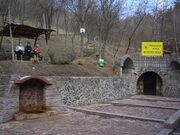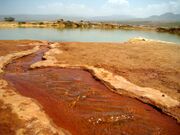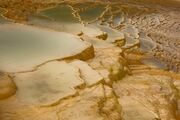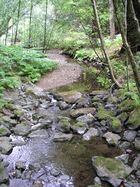ينبوع معدني


Mineral springs are naturally occurring springs that produces hard water, water that contains dissolved minerals. Salts, sulfur compounds, and gases are among the substances that can be dissolved in the spring water during its passage underground. In this they are unlike sweet springs, which produce soft water with no noticeable dissolved gasses. The dissolved minerals may alter the water's taste. Mineral water obtained from mineral springs, and the precipitated salts, have long been an important commercial product (e.g. Epsom salts).
Some mineral springs may contain significant amounts of harmful dissolved minerals, such as arsenic, and should not be drunk.[1][2] Sulfur springs smell of rotten eggs due to hydrogen sulfide (H2S), which is hazardous and sometimes deadly. It is a gas, and it usually enters the body when it is breathed in.[3] The quantities ingested in drinking water are much lower and are not considered likely to cause harm, but few studies on long-term, low-level exposure have been done, اعتبارا من 2003[تحديث].[4]
The water of mineral springs is sometimes claimed to have therapeutic value. Mineral spas are resorts that have developed around mineral springs, where (often wealthy) patrons would repair to 'take the waters' — meaning that they would drink (see hydrotherapy and water cure) or bathe in (see balneotherapy) the mineral water. Historical mineral springs were often outfitted with elaborate stone-works — including artificial pools, retaining walls, colonnades and roofs — sometimes in the form of fanciful 'Greek temples', gazebos or pagodas. Others were entirely enclosed within spring houses.
Types
For many centuries, in Europe, North America and elsewhere, commercial proponents of mineral springs classified them according to the chemical composition of the water produced and according to the medicinal benefits supposedly accruing from each:
- Arsenical springs contained arsenic
- Lithia springs contained lithium salts.
- Chalybeate springs contained salts of iron.
- Alum springs contained alum.
- Sulfur springs contained hydrogen sulfide gas (see also fumeroles).
- Salt (saline) springs contained salts of calcium, magnesium or sodium.
- Alkaline springs contained an alkali.
- Calcic springs contained lime (calcium hydroxide).
- Thermal (hot) springs could contain a high concentration of various minerals.
- Soda springs contained carbon dioxide gas (soda water).
- Radioactive springs contain traces of radioactive substances such as radium or uranium.
الترسبات
Types of sedimentary rock – usually limestone (calcium carbonate) – are sometimes formed by the evaporation, or rapid precipitation, of mineral spring water, especially at the mouths of hot mineral springs. (These mineral deposits can also be found in dried lakebeds.) Spectacular formations, including terraces, stalactites, stalagmites and 'frozen waterfalls' can result (see, for example, Mammoth Hot Springs).
One light-colored porous calcite of this type is known as travertine and has been used extensively in Italy and elsewhere as building material. Travertine can have a white, tan, or cream-colored appearance and often has a fibrous or concentric 'grain'.
Another type of spring water deposit, containing siliceous as well as calcareous minerals, is known as tufa. Tufa is similar to travertine but is even softer and more porous.
Chaybeate springs may deposit iron compounds such as limonite. Some such deposits were large enough to be mined as iron ore.
انظر أيضاً
- قائمة الينابيع الحارة
- Sweet springs, those with no detectable sulfur or salt content
المراجع
- ^ "Import Alert 29-02: Detention Without Physical Examination of Bottled Water due to Arsenic Due to Inorganic Arsenic". www.accessdata.fda.gov. FDA.
- ^ "Bottled water brand with high levels of arsenic pulled from store shelves". NBC News.
- ^ "PUBLIC HEALTH STATEMENT: Hydrogen Sulfide" (PDF). DEPARTMENT of HEALTH AND HUMAN SERVICES, Public Health ServiceAgency for Toxic Substances and Disease Registry, US Centers for Disease Control. December 2016.
- ^ "Hydrogen Sulfide in Drinking-water" (PDF). World Health Organization. 2003.
- Cohen, Stan (Revised 1981 edition), Springs of the Virginias: A Pictorial History, Charleston, West Virginia: Quarrier Press.
- Springs and Bottled Water of the World: Ancient History, Source, Occurrence, Quality and use, Berlin / Heidelberg / New York: Springer-Verlag, 2001, ISBN 3-540-61841-4, https://books.google.com/books?id=sjEoBmfUka0C&q=springs+bottled, retrieved on 13 July 2010
- Short description matches Wikidata
- Articles with hatnote templates targeting a nonexistent page
- Missing redirects
- مقالات فيها عبارات متقادمة منذ 2003
- جميع المقالات التي فيها عبارات متقادمة
- Springs (hydrology)
- Drinking water
- Spa waters
- Water chemistry
- Bathing
- Natural environment based therapies
- Geomorphology
- Mineral water



